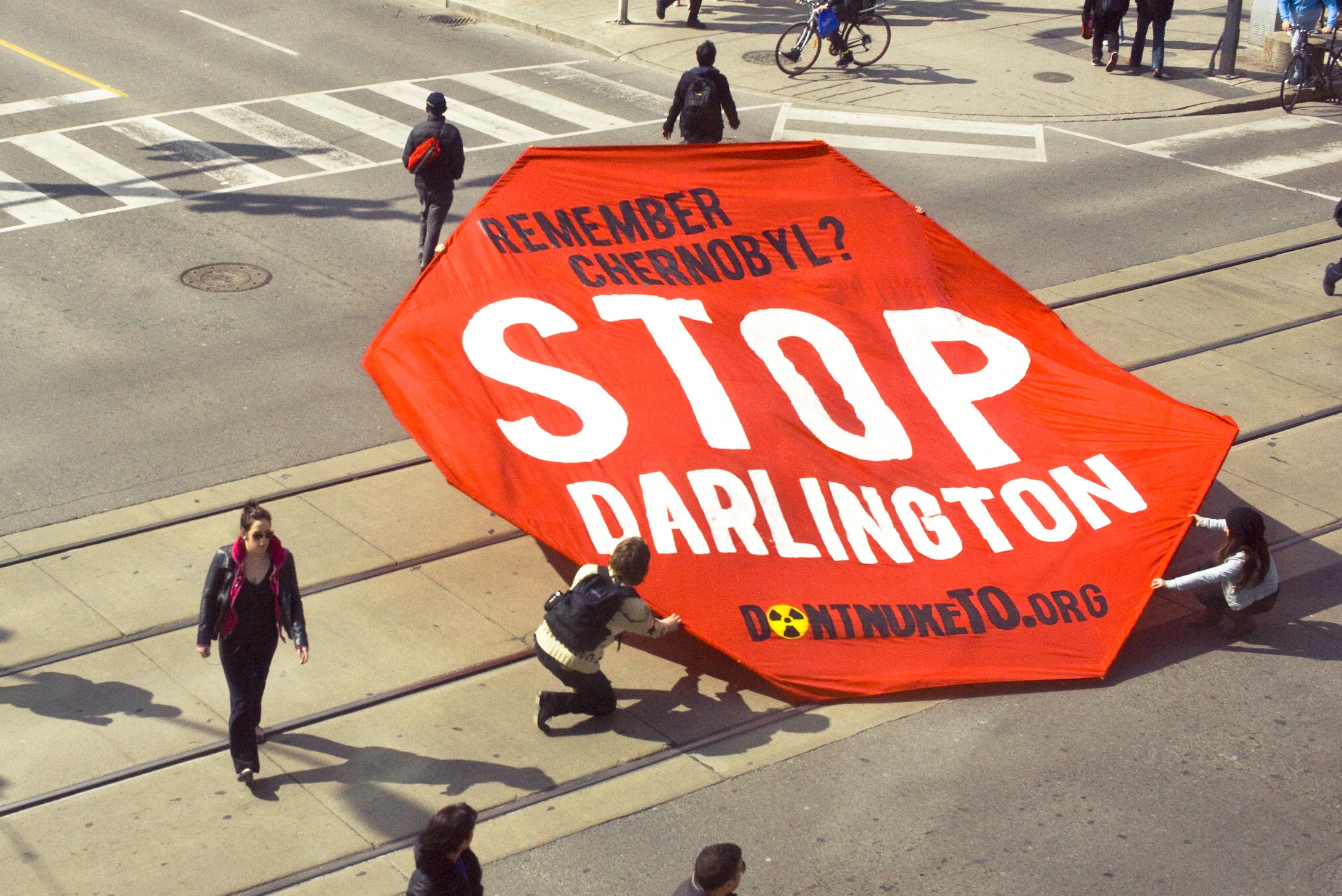On Wednesday morning, as part of Toronto-based anti-nuke group DONT NUKE TO!, I commemorated the anniversary of the Chernobyl nuclear disaster by unfurling an enormous stop sign banner in the middle of the intersection of Yonge and Dundas in the centre of Toronto.
I was in the intersection of Yonge and Dundas simply because I’m 27 years old and I’ve been alive for four nuclear meltdowns — unit 4 at Chernobyl, and units 1, 2, and 3 at Fukushima Daiichi.
I’ve seen reports of the radioactive materials contaminating more that 125,000 square kilometres in the Ukraine, Russia and Belarus, causing hundreds of thousands of people to be relocated, willingly and otherwise. I’ve also seen the 30km exclusion zone around Chernobyl, an area that includes the once bustling city of Pripyat, which has now become a site of post-apocalyptic curiousity.
There is also the matter of Chernobyl’s collapsing ad hoc ‘Sarcophagus’, the concrete structure built to contain the radioactive contents of reactor four. The Sarcophagus around Chernobyl is rapidly deteriorating, and no longer a reliable guard against the radioactivity of the station. An international campaign launched by the European Commission to fund a new containment at Chernobyl is hoping to be completed by 2015.
In other words, I commemorated Chernobyl’s anniversary in hopes of making clear the ongoing and horrific impacts of nuclear energy. When this unruly technology isn’t contained, it can cause mass displacement, radioactive contamination of vital land and require indefinite vigilance to prevent more fallout.
In Ontario, where our government intends to build two new reactors and rebuild four others at the Darlington Nuclear Station, it is especially important to consider the risks of continuing with nuclear.
A 2011 report by the Centre for Spatial Economics (C4SE) outlined some of the effects of a nuclear disaster at the Darlington Nuclear Station. The Centre found that an accident at Darlington severe enough to enact a 20km exclusion zone for a year-long period would displace 465,000 residents and make their 167,000 households uninhabitable.
In economic terms, a one-year exclusion zone around Darlington would shut down 150,000 workplaces and prevent the region from generating $10 billion in gross domestic product. There is also the small matter of making the 401 highway and the CN, Via Rail and GO train lines that run parallel to it impassable in the 20km exclusion zone around Darlington.
All of these results, C4SE indicates, would intensify in impact if the exclusion zone were to be maintained for more than one year.
Even after Chernobyl and Fukushima, the Canadian Nuclear Safety Commission still asserts that the Canadian reactor, the CANDU, “does not pose significant risks”. However, there are some legitimate concerns specific to Canadian reactors.
However, the CANDU reactor shares a significant design flaw with Chernobyl’s reactors -positive reactivity. This means that like Chernobyl’s RBMK design, the CANDU can experience a violent and sudden increase in energy output if the flow of cooling water is interrupted and the safety shutdowns fail.
If there is a sudden and unmitigated burst of energy in a reactor, as seen in Chernobyl, explosions can happen quickly and a meltdown of the reactor core is soon to follow.
Since Chernobyl, there have been some efforts on the part of international regulators to tighten the safety of nukes. In 2000, the International Atomic Energy Agency set global safety standards for new reactors to be inherently safe, or in other words, free of fundamentally hazardous design concepts.
Because positive radioactivity is a hazardous feature of its design, the CANDU does not meet new international standards of inherent safety.
While Canada’s nuclear industry has optimistically pointed to the availability of a new design without this problem, the ACR-1000, it has never actually been built. At this point, it’s merely an expensive concept.
What’s more, 11 years after the CANDU design no longer met international standards, the old CANDU with its inherently hazardous design crept onto the list of potential new reactor types for Darlington.
This means that despite international standards, and the demonstrated risks involved in this design, Ontario might get stuck with brand new, old nuclear reactors. Add the proposed life-extension of four more CANDU reactors at Darlington and the risks for Ontario escalates.
Yesterday morning, that banner I helped unfurl read “Remember Chernobyl? Stop Darlington,” causing conversations about a different energy future to perculate all around me.
In that intersection of Dundas and Yonge, we stood — about 60 km away from Darlington and only 30 km from Pickering Nuclear Station — working on a energy future without any more Chernobyls or Fukushimas.
Steve Cornwell is an MA candidate at York University. He is interested in the interactions of social movements, science and technology. Steve has worked on energy issues with Greenpeace Canada, Environmental Defense, and Safe and Green Energy Peterborough. Follow Steve Cornwell at Twitter.com/Steve_Cornwell



